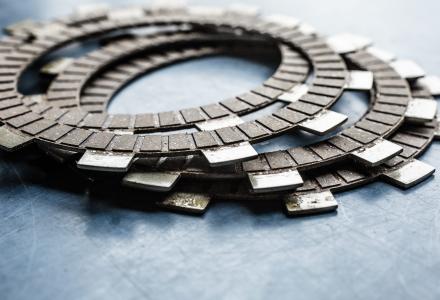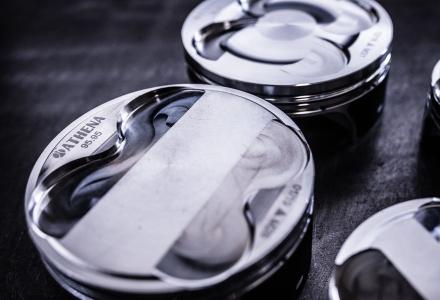Motorcycle Fork Overhaul: How and When
Motorcycle forks are one of the most crucial elements of a motorcycle as they directly impact safety and riding pleasure. Correct and regular maintenance and overhauls should be a priority for every biker, whether on-road or off-road.
Specifically, the front forks and rear shock absorbers enable the motorcycle to maintain traction on the road, especially during cornering, and ensure the rider's comfort even on uneven surfaces. To preserve their performance over time, motorcycle forks require regular maintenance. In this article, we will cover how to perform a motorcycle fork overhaul, how to identify when it is time to do it and how often, the necessary equipment for the task, and ballpark costs for a motorcycle fork overhaul.

Understanding Motorcycle Forks and What They Do
Let's first understand what a motorcycle front fork is and how it is made. The fork, along with the rear shock absorber (which we won't discuss in this article), is primarily composed of two parts: the spring, which generates elastic force, and the hydraulic element, which generates viscous friction force. The elastic force is related to the compression and decompression of the spring and is the first response to dynamic events that affect the motorcycle, such as changes in posture during cornering, riding over bumps on the ground, and the stress forces generated by acceleration and deceleration. However, the spring alone has a conservative force: the energy is not dissipated but immediately returned. If we relied solely on the spring, the motorcycle would continuously and uncontrollably bounce, which is why the hydraulic element is introduced to damp this motion.
In particular, all motocross forks are of the hydraulic type, even if they have traditional coil springs. The air trapped inside the fork tubes creates pressure when the fork heats up due to friction from movement or ambient air temperature.
Motorcycle Fork Overhaul: How Often and Why It's Important
Over time and with mileage, each front fork loses its reactivity and efficiency, and therefore requires an overhaul. Many motorcyclists think of overhauling the forks only when there is a problem, such as an oil leak due to a broken oil seal. However, regular maintenance is crucial. For on-road motorcycles, front fork overhauls should be done every 2-3 years or every 20-25,000 km (depending on which occurs first). For off-road motorcycles, which subject the forks to greater stress and wear, it's advisable to perform their overhaul every year.
But how do you know if the forks need an overhaul? For air forks, the most common type, if there's a constant loss of pressure even shortly after inflation, it is time for an overhaul, which includes replacing the oil seals and O-rings, as well as changing the oil. In motocross motorcycles, the first signs of worn oil seals are the presence of oil on the front fork tubes. The front fork should move freely; if the fork feels too stiff, the front of the motorcycle tends to bounce, so it is essential to ensure there are no oil stains on the fork tubes and that there is no excessive stiffness in the front.

Motorcycle Fork Overhaul: At the Repair Shop or DIY?
There are different levels of intervention for a front fork overhaul. The easier and more accessible tasks for everyone include checking the oil seals and dust seals. On the other hand, the overhaul of internal components usually requires some experience and skill, or it is best to entrust it to the hands of your trusted mechanic. Replacing the oil is an intermediate-level task, requiring some practice but not impossible to handle. However, keep in mind that if you start disassembling a front fork and cannot complete the overhaul and reassembly, you risk damaging it and potentially incurring significant costs.
How to Overhaul Motorcycle Forks: Equipment and Steps
Let's see how to perform the simpler tasks for fork overhaul: changing the oil and replacing the oil seals and dust seals. If you want to do the overhaul on your own, you will need some tools to complete the job correctly and perform a good overhaul. A list of tools can be found below.
- Pump Holder Wrench: A metal tube that screws onto the pump holder, acting as an extension, used to drain the old oil from the fork.
- A syringe with a graduated rod and a plastic tube: it helps to inject the right amount of oil and check the ideal level.
- Tools for installing fork seals: to assemble the bushings and seals on traditional forks and upside-down forks.
- T-Bar Cartridge Removal Tool: to separate the fork tube from the stem.
How to Change Oil in a Closed Cartridge Fork
Now, let’s see how to proceed with the oil change procedure in a traditional closed cartridge front fork. It is highly recommended to perform the operation on both front forks to avoid differences in performance between them that could affect the motorcycle's stability.
- Disassemble the front fork, drain the oil, and begin disassembly from the lower bolt.
- Remove the return valve shaft, release the gas inside (usually a needle is enough after removing the plug screw), and then disassemble the internal part of the cartridge.
- Now, insert the new oil, usually with a syringe, making sure to move the shaft slightly to ensure there are no air bubbles.
- Once the oil is inserted, start reassembling the fork in reverse order, remembering to re-introduce the air (or nitrogen, depending on the type of gas originally used in the fork).
How to Change Oil Seals and Dust Seals
- Disassemble the fork.
- Detach the dust seal from the lower leg.
- Remove the metal clip that holds the oil seal in place.
- Take out the old oil seal by sliding it off the fork tube and fork slider.
- Remember to clean the area with a clean cloth to remove dust and any dirt.
- Lubricate the fork tube (you can use fork oil).
- Insert the new oil seal, then secure it with the clip and dust seal.
- Reassemble the fork.
Keep in mind that a thorough overhaul restores the motorcycle forks' performance but cannot improve it beyond its original state. If your goal is to enhance performance, the only solution is to replace the forks with a new pair of higher quality.
Athena offers a wide range of oil seal and dust seal replacement kits for forks on its website, suitable for both on-road motorcycles and motocross/off-road bikes. Each kit includes a compatibility list showing the motorcycle models for which it is suitable.
How much does a motorcycle fork overhaul cost?
As you can imagine, there are no fixed rates, and the cost depends on various factors. The longer the usage, the more likely it is that dirt may have damaged the wear parts, leading to the need to replace bushings, seals, or O-rings. The necessary interventions and their costs can only be determined once the fork has been disassembled. As a ballpark idea, a front fork overhaul, which generally includes cleaning, polishing the fork tubes, internal cleaning of the tubes, sliders, and hydraulic cartridge, checking the clearance of the tubes and sliders, oil change, replacement of oil seals, and adjustments, can cost between 190 and 300 euros.




